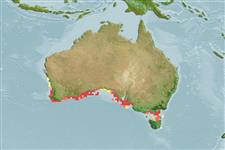Classification / Names
Noms communs | Synonymes | Catalog of Fishes(Genre, Espèce) | ITIS | CoL | WoRMS | Cloffa
>
Ophidiiformes (Cusk eels) >
Dinematichthyidae (Viviparous brotula)
Etymology: Dactylosurculus: Name from Latin 'dactylus' or Greek 'dactylos' for finger and Latin 'surculus' for sucker of a grapevine tendril. Name refers to the functional analogy with the pseudoclaspers, to the specific shape of the ‘middle’ pseudoclasper.; gomoni: Named for Martin Gomon, NMV, Melbourne, Australia,.
More on authors: Schwarzhans & Møller.
Environment: milieu / climate zone / depth range / distribution range
Écologie
marin démersal; profondeur 2 - 10 m (Ref. 76869). Subtropical
Eastern Indian Ocean: Western Australia.
Taille / Poids / Âge
Maturity: Lm ? range ? - ? cm
Max length : 6.0 cm SL mâle / non sexé; (Ref. 76869); 7.4 cm SL (female)
Description synthétique
Clés d'identification | Morphologie | Morphométrie
Rayons mous dorsaux (Total) : 92 - 109; Rayons mous anaux: 70 - 81; Vertèbres: 45 - 50. This species is distinguished by the following set of characters: anterior nostril low on snout; copulatory organ of males with 3 pairs of pseudoclaspers, all joined at base in narrow stalked stem, the outer pseudoclasper is wing-shaped, V-shaped flap-like inner pseudoclasper anteriorly joined to outer pseudoclasper, short, second inner pseudoclasper inserted between the two, intermediate in length, finger-like in shape, with
supporter; moderately large species, reaching to about 7.0 cm SL; 13-14 precaudal vertebrae, 45-50 total vertebrae; 22-26 pectoral fin rays; 8-9 branchiostegal rays; a small scale patch on upper cheek only on the head; scales on operculum absent; upper preopercular pore present; small pore below the eye; elongated otolith, its length to height 2.1-2.3, inclined sulcus, fused colliculi; maxilla is expanded posterio-ventrally (Ref. 76869).
Life cycle and mating behavior
Maturities | Reproduction | Spawnings | Egg(s) | Fecundities | Larves
Schwarzhans, W. and P.R. Møller, 2007. Review of the Dinematichthyini (Teleostei: Bythitidae) of the Indo-west Pacific. Part III. Beaglichthys, Brosmolus, Monothrix and eight new genera with description of 20 new species. The Beagle, Records of the Museums and Art Galleries of the Northern Territory 23:29-110. (Ref. 76869)
Statut dans la liste rouge de l'IUCN (Ref. 130435)
Utilisations par l'homme
Outils
Articles particuliers
Télécharger en XML
Sources Internet
Estimates based on models
Preferred temperature (Ref.
123201): 15.3 - 18.8, mean 17.5 °C (based on 159 cells).
Phylogenetic diversity index (Ref.
82804): PD
50 = 1.0000 [Uniqueness, from 0.5 = low to 2.0 = high].
Bayesian length-weight: a=0.00389 (0.00180 - 0.00842), b=3.12 (2.94 - 3.30), in cm total length, based on all LWR estimates for this body shape (Ref.
93245).
Niveau trophique (Ref.
69278): 3.3 ±0.5 se; based on size and trophs of closest relatives
Fishing Vulnerability (Ref.
59153): Low vulnerability (10 of 100).
